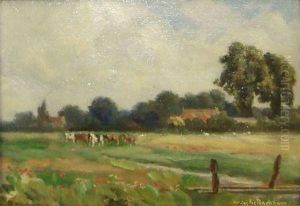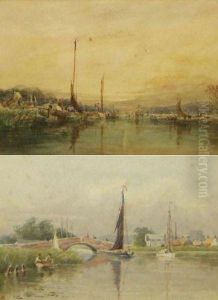William Leslie Bowles Paintings
William Leslie Bowles was an Australian sculptor whose work and influence spanned the first half of the 20th century. Born on 26 February 1885 in Leichhardt, New South Wales, Bowles emerged as a significant figure in Australian art, particularly known for his sculptures in bronze and marble. His contributions to the art world were not only through his creations but also through his role as a teacher and mentor to future generations of artists.
Bowles' artistic journey began with his education at the National Gallery of Victoria Art School in Melbourne, where he honed his skills under the tutelage of Bernard Hall and Frederick McCubbin, among others. This foundational period was crucial in developing his classical approach to sculpture, which later became a hallmark of his work. In 1915, his career was interrupted by World War I, during which he served with the Australian Imperial Force. The experiences and horrors of the war would later influence some of his works, infusing them with a depth of emotion and a reflection on human suffering and resilience.
After the war, Bowles' reputation as a sculptor grew, both in Australia and internationally. He was known for his memorial works, which commemorated the sacrifices of soldiers in World War I. One of his most famous works is the 'Simpson and His Donkey' memorial, located at the Australian War Memorial in Canberra, which pays tribute to the iconic figure of John Simpson Kirkpatrick, a stretcher-bearer who saved many lives during the Gallipoli campaign. This work, in particular, exemplifies Bowles' ability to capture the human spirit and the essence of heroism in bronze.
In addition to memorials, Bowles produced a wide range of sculptures, including portraits, figures, and decorative works that were acclaimed for their technical prowess and emotional depth. His style, while rooted in classical traditions, also reflected the influence of Art Nouveau and later, Art Deco movements, showcasing his ability to adapt and evolve with the times.
Beyond his contributions as an artist, Bowles was instrumental in the development of the Australian art scene through his teaching positions. He served as a lecturer and head of the sculpture department at the Royal Melbourne Institute of Technology (RMIT), where he inspired and nurtured the talents of many young artists. His dedication to education and the arts was recognized with several awards and honors throughout his career.
William Leslie Bowles passed away on 21 February 1954, leaving behind a legacy that continues to be celebrated in Australian art history. His works are held in numerous public and private collections, serving as enduring reminders of his skill, vision, and the pivotal role he played in the cultural life of Australia during the early to mid-20th century.

